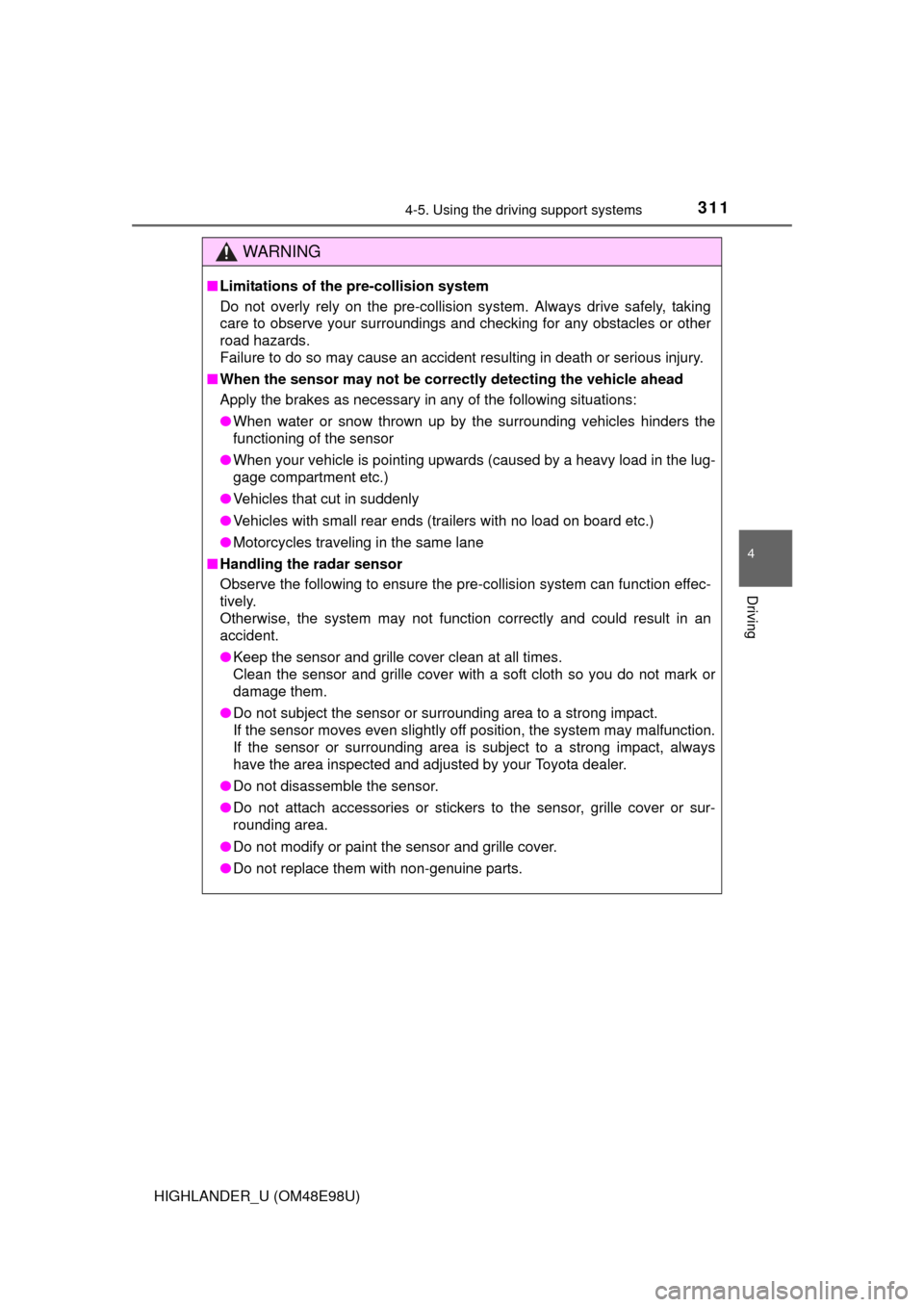Page 278 of 712

2784-5. Using the driving support systems
HIGHLANDER_U (OM48E98U)
WARNING
■Situations unsuitable for dynamic radar cruise control
Do not use dynamic radar cruise control in any of the following situations.
Doing so may result in inappropriate speed control and could cause an acci-
dent resulting in death or serious injury.
● In heavy traffic
● On roads with sharp bends
● On winding roads
● On slippery roads, such as those covered with rain, ice or snow
● On steep downhills, or where there are sudden changes between sharp up
and down gradients
Vehicle speed may exceed the set speed when driving down a steep hill.
● At entrances to expressways
● When weather conditions are bad enough that they may prevent the sen-
sors from functioning correctly (fog, snow, sandstorm, heavy rain, etc.)
● When an approach warning buzzer is heard often
● When your vehicle is towing a trailer or during emergency towing
■ When the sensor may not be correct ly detecting the vehicle ahead
Apply the brakes as necessary when any of the following types of vehicle\
s
are in front of you.
As the sensor may not be able to correctly detect these types of vehicles,
the approach warning ( P. 272) will not be activated, and a fatal or serious
accident may result.
● Vehicles that cut in suddenly
● Vehicles traveling at low speeds
● Vehicles that are not moving
● Vehicles with small rear ends (trailers with no load on board etc.)
● Motorcycles traveling in the same lane
Page 311 of 712

3114-5. Using the driving support systems
4
Driving
HIGHLANDER_U (OM48E98U)
WARNING
■Limitations of the pre-collision system
Do not overly rely on the pre-collision system. Always drive safely, taking
care to observe your surroundings and checking for any obstacles or other
road hazards.
Failure to do so may cause an accident resulting in death or serious injury.
■ When the sensor may not be correct ly detecting the vehicle ahead
Apply the brakes as necessary in any of the following situations:
● When water or snow thrown up by the surrounding vehicles hinders the
functioning of the sensor
● When your vehicle is pointing upwards (caused by a heavy load in the lug-
gage compartment etc.)
● Vehicles that cut in suddenly
● Vehicles with small rear ends (trailers with no load on board etc.)
● Motorcycles traveling in the same lane
■ Handling the radar sensor
Observe the following to ensure the pre-collision system can function effec-
tively.
Otherwise, the system may not function correctly and could result in an
accident.
● Keep the sensor and grille cover clean at all times.
Clean the sensor and grille cover with a soft cloth so you do not mark or
damage them.
● Do not subject the sensor or surrounding area to a strong impact.
If the sensor moves even slightly off position, the system may malfunction.
If the sensor or surrounding area is subject to a strong impact, always
have the area inspected and adjusted by your Toyota dealer.
● Do not disassemble the sensor.
● Do not attach accessories or stickers to the sensor, grille cover or sur-
rounding area.
● Do not modify or paint the sensor and grille cover.
● Do not replace them with non-genuine parts.
Page 319 of 712

3194-5. Using the driving support systems
4
Driving
HIGHLANDER_U (OM48E98U)■
Conditions under which the Blind Spot Monitor function may not func-
tion correctly
●The Blind Spot Monitor function may not detect vehicles correctly in the fol-
lowing conditions:
• During bad weather such as heavy rain, fog, snow etc.
• When ice or mud etc. is attached to the rear bumper
• When driving on a road surface that is wet due to rain, standing water etc.
• When there is a significant difference in speed between your vehicle and
the vehicle that enters the detection area
• When a vehicle is in the detection area from a stop and remains in the detection area as your vehicle accelerates
• When driving up or down consecutive steep inclines, such as hills, a dip
in the road etc.
• When multiple vehicles approach with only a small gap between each vehicle
• When vehicle lanes are wide, and the vehicle in the next lane is too far away from your vehicle
• When the vehicle that enters the detection area is traveling at about the
same speed as your vehicle
• When there is a significant difference in height between your vehicle and the vehicle that enters the detection area
• Directly after the BSM main switch is set to on
• When towing a trailer
● Instances of the Blind Spot Monitor function unnecessarily detecting a vehi-
cle and/or object may increase under the following conditions:
• When there is only a short distance between your vehicle and a guardrail,
wall etc.
• When there is only a short distance between your vehicle and a following vehicle
• When vehicle lanes are narrow and a vehicle driving 2 lanes across from
your vehicle enters the detection area
• When items such as a bicycle carrier ar e installed on the rear of the vehi-
cle
Page 322 of 712

3224-5. Using the driving support systems
HIGHLANDER_U (OM48E98U)■
Conditions under which the Rear Cr oss Traffic Alert function will not
detect a vehicle
The Rear Cross Traffic Alert function is not designed to detect the following
types of vehicles and/or objects.
● Small motorcycles, bicycles, pedestrians etc.
*
●Vehicles approaching from directly behind
● Guardrails, walls, signs, parked vehicles and similar stationary objects
*
●Vehicles moving away from your vehicle
● Vehicles approaching from the parking spaces next to your vehicle
*
●Vehicles backing up in the parking space next to your vehicle*
*
: Depending on conditions, detection of a vehicle and/or object may occur.
■ Conditions under which the Rear Cross Traffic Alert function may not
function correctly
The Rear Cross Traffic Alert function may not detect vehicles correctly in the
following conditions:
● When ice or mud etc. is attached to the rear bumper
● During bad weather such as heavy rain, fog, snow etc.
● When multiple vehicles approach continuously
● Shallow angle parking
● When a vehicle is approaching at high speed
● When parking on a steep incline, such as hills, a dip in the road etc.
● Directly after the BSM main switch is set to on
● Directly after the engine is started with the BSM main switch on
● When towing a trailer
● Vehicles that the sensors cannot detect
because of obstacles
Page 632 of 712
632
HIGHLANDER_U (OM48E98U)
9-1. Specifications
*1: Unladen vehicles
*2: With a seating capacity of 7 occupants
*3: With a seating capacity of 8 occupants
*4: Without a towing package
*5: With a towing package
Maintenance data (fuel, oil level, etc.)
Dimensions and weights
Overall length191.1 in. (4855 mm)
Overall width 75.8 in. (1925 mm)
Overall height*1
Without roof antenna
68.1 in. (1730 mm)
With roof antenna
70.1 in. (1780 mm)
Wheelbase 109.8 in. (2790 mm)
Front tread64.4 in. (1635 mm)
Rear tread 64.2 in. (1630 mm)
Vehicle capacity weight
(Occupant + luggage)1385 lb. (625 kg)*2
1455 lb. (660 kg)*3
Trailer Weight Rating
(Trailer weight + cargo weight)
2.7 L 4-cylinder (1AR-FE)
engine
1500 lb. (680 kg)
3.5 L V6 (2GR-FE) engine
2000 lb. (900 kg)
*4
5000 lb. (2000 kg)*5
Page 644 of 712
6449-1. Specifications
HIGHLANDER_U (OM48E98U)
■When towing a trailer (245/55R19 103T tires)
On rear tires, add 1 psi (10.0 kPa, 0.1 kgf/cm
2 or bar) to the recom-
mended tire inflation pressure and drive at speeds below 65 mph (104
km/h).
Page 709 of 712

709Alphabetical index
HIGHLANDER_U (OM48E98U)
Tires .......................................... 515Chains................................... 325
Checking ............................... 515
If you have a flat tire ............. 590
Inflation pressure .................. 642
Information ............................ 649
Replacing .............................. 590
Rotating tires......................... 515
Size ....................................... 642
Snow tires ............................. 326
Spare tire .............................. 590
Tire pressure warning
system ......... ....................... 516
Warning light ......................... 565
Tools ......................................... 591
Top tether strap ......................... 75
Towing Dinghy towing ....................... 224
Emergency towing ................ 557
Trailer towing ........................ 207
TRAC (Traction Control) ......... 298
Traction Control (TRAC) .................................... 298
Trailer towing .......................... 207
Transmission ........................... 234 Automatic transmission......... 234
If the shift lever cannot be shifted from P ..................... 617
S mode ................................. 236
Turn signal lights..................... 239
Replacing light bulbs............. 539
Turn signal lever ................... 239
Wattage ................................ 645 USB port ................................... 342
Utility vehicle precautions ...... 327
Valet key ................................... 114
Vanity lights ............................. 455
Wattage ................................ 645
Vanity mirrors .......................... 455
Vehicle data recordings .............. 9
Vehicle identification number ................................... 633
Vehicle Stability Control (VSC) ...................................... 298
Voice command system
*....... 417
VSC (Vehicle Stability Control) .................................. 298
U
V
*: Refer to “Navigation and Multimedia System Owner’s Manual”